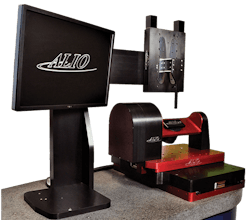Laser processing of 3D substrates benefits from 5-axis gimbal positioning
Processing materials with a laser requires high-speed precision path control while keeping the laser beam at normal incidence and optimum focal length on curved, flexible, or brittle surfaces. Synchronized movement of multiple linear and rotational axes using novel forward and inverse kinematic equations to accurately control deposition and thickness of nanoparticle inks, for example, also requires precision multi-axis positioning systems that synchronize laser pulses with rapidly moving part positions.
If you thought that three dimensions was enough to manage such complex machining operations, consider what a five-axis gimbal positioner offers: 5D vector path laser triggering from ALIO Industries (Arvada, CO) positions the laser beam at a nominal focal length and incidence angle in five dimensions, including three linear axes (x, y, and z) and two rotational axes theta-z (A) and theta-y (B). Most engineers are familiar with x, y, z positioning, which typically supports processing on flat (planar) substrates. Positioning in five-axis space adds the ability to process complex nonplanar components containing features on multiple surfaces with a standard processing work envelope of 395 × 320 × 170 mm and with angular travel ranges of up to ±172° in theta-y and continuous 360° in theta-z. Linear-axis accuracy is better than ±1 µm with bidirectional repeatability of less than ±50 nm and 0.5 arcsec for the rotary axes. Reference: https://goo.gl/mkqjmp.
About the Author

Gail Overton
Senior Editor (2004-2020)
Gail has more than 30 years of engineering, marketing, product management, and editorial experience in the photonics and optical communications industry. Before joining the staff at Laser Focus World in 2004, she held many product management and product marketing roles in the fiber-optics industry, most notably at Hughes (El Segundo, CA), GTE Labs (Waltham, MA), Corning (Corning, NY), Photon Kinetics (Beaverton, OR), and Newport Corporation (Irvine, CA). During her marketing career, Gail published articles in WDM Solutions and Sensors magazine and traveled internationally to conduct product and sales training. Gail received her BS degree in physics, with an emphasis in optics, from San Diego State University in San Diego, CA in May 1986.
